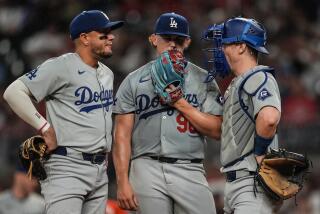He Has Turned His Meal Ticket Into Art Form
Picture if you will somebody coming into a room to find Mozart tinkling on a piano and exploding, “Amadeus! How many times I got to tell you, stick to the accordion. You’ll never get anywhere with those little night music shticks.”
Or supposing they found Heifetz drawing a bow across his violin and shouted, “No, no, no, Jascha! Enough with the Bruch concertos, you gotta play some hoedown music for the square dances. That’s where the money is.”
What if they told Michelangelo, “No, no, Mike, just paint the ceiling blue. No pictures. We don’t want graffiti all over the Vatican. What is this, a cigarette ad or a house of worship?”
And to bring it to the less sublime, suppose they came upon Babe Ruth taking batting practice one day and they yelled, “Are you crazy, George Herman? Pitchers can’t hit. Get back on the mound. That’s where your future is, that’s what you’ll be remembered for.”
Well, Tom Candiotti is a long way in sheer talent from these worthies. But he can identify with them or with anyone advised to throw away his real talent and concentrate on something that might consign him to oblivion.
Tom Candiotti, as it happens, is one of the best pitchers in the big leagues. His earned-run average is a glittering 2.49. He has 124 strikeouts, more than anyone on the Dodger staff, and he has a record of 8-5.
The point is, Tom Candiotti is doing it all with something he does best but which everyone tried to discourage him from doing--throw the knuckleball.
You see, no one loves the knuckleball. It is the orphan pitch of the major leagues. Managers think knuckleballers should be drowned at birth like male alligators. It has been said it is a pitch the hitters can’t hit, the catchers can’t catch and the umpires can’t call.
Managers hate it because their ulcer kicks in every time a runner gets to third base and a knuckleballer is on the mound for them. They’re not too happy when a base-stealer gets on first with a knuckleball pitcher on the mound.
So, Tom Candiotti had to smuggle it aboard when he first came into baseball. It’s as if he had a dark secret, like a prison record or a history of schizophrenia.
He masqueraded, so to speak, as a conventional pitcher--fastball, change-up, curve or slider. He was only moderately successful, drifting around in the minor leagues with lackluster stuff, getting hitters out but reminding no one of Roger Clemens--or even Steve Rogers--in the process.
He got a tryout with Milwaukee, but they kept dropping him down to the minor leagues. His fastball wasn’t fast enough, his breaking ball hung. His control was good. He would be perfect for batting practice.
But he had this saver in the bottom of the trunk--the knuckler. His father had taught it to him as a youngster growing up in Northern California, but succeeding managers and coaches had discouraged its use.
One day, he couldn’t stand it anymore. He got a friend to catch him and he began to throw knuckleballs. “I was beating him up. He was lunging, dropping, chasing. The ball was all over the place. He couldn’t handle it.”
Unbeknown to him, two Brewer officials, Manager George Bamberger and vice president Sal Bando, were in the background watching.
Now, picture if you will, if somebody had heard Mozart play and instead of discouraging him said, “Hey, kid. You’re good. I didn’t know you could get that out of a piano.” Or if someone told Heifetz, “Boy, stick to the classical stuff. You’re not a fiddler, you’re an artist.” And somebody said to Babe Ruth, “Pitch, hell! Get that man a bat.”
Bamberger and Bando were impressed. “Kid, that’s the best knuckleball I’ve ever seen,” Bamberger told him. “Why don’t you throw it in a game?”
So, Tom Candiotti did. He signed with Cleveland as a free agent in 1985 and the Indians assigned him to a triple-A contract, expecting the old Candiotti. The new one showed up with his contraband pitch--and his days of being sent down to the minor leagues were over. He went 16-12 in 1986 and later posted 14-8, 15-11 and 13-10 seasons with the Indians.
He’s as hard to hit as any pitcher on the Dodger staff--or in the league.
The trouble with the knuckleball is its capacity to self-destruct. It has a mind of its own once the pitcher lets go of it. It drifts in a current of air. The late Roy Campanella once called the curveball, “Public Enemy No. 1.” If so, the knuckleball is a serial killer. It’s like a mad dog that can turn on its owner.
But Tom Candiotti was finally doing what he does best.
“(Former relief pitcher) Tom House did a study and he found there were only about 20 knuckleball pitchers in the game’s history who relied almost strictly on the knuckleball,” he tells you.
Tom Candiotti almost didn’t join that select group. He got rescued from anonymity by Bamberger and Bando. If they hadn’t come along when they had, he might still be trying to outguess college kids with off-speed conventional stuff.
It’s probably not exactly like Heifetz being rescued from a career playing barn dances, or Michelangelo from doing ceilings with a roller, but when the knuckleball is working right, it is, after all, a work of art. A knuckleball pitcher is the ultimate abstractionist.
More to Read
Go beyond the scoreboard
Get the latest on L.A.'s teams in the daily Sports Report newsletter.
You may occasionally receive promotional content from the Los Angeles Times.










